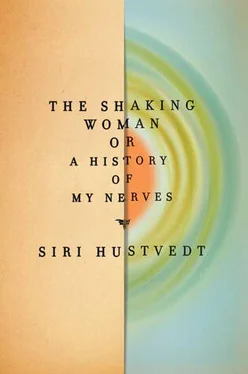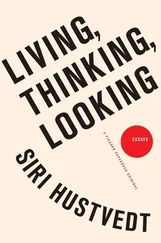One may ask why this condition — or, rather, state of being — has only recently been identified. The answer, in part, is mirror neurons. One theory is that in people like me they are overactive. Without Gallese, Rizzolatti and their colleagues’ discovery and the research that followed, my version of synesthesia would probably have remained unidentified in the world of hard science, a psychological state without an organic concomitant. Neurobiologists would have regarded it with skepticism (as they did all forms of synesthesia, until it became clear that it could be understood as a function of genetic and neural processes) or they simply would have ignored it as a subject beyond their ken. Without a biologically plausible hypothesis, a study is not possible. The wane of behaviorism in psychology has, no doubt, also played a role. Suddenly, subjective states, at least in some circles, have become a reasonable focus of study. Anglo-American analytical philosophers, writing in the Journal of Consciousness Studies, debate endlessly the problem of qualia —each person’s phenomenal, personal experience of the world, which cannot (according to some) be reduced to a description of activated neuronal circuits or “information processing.” There are scientists in various fields who would disagree with the reductionist formulation “You are a vast assembly of nerve cells.”
Many people experience relief when they discover that a trait that has always been with them has a name, belongs to a legitimate scientific category, and is part of a greater taxonomy of illnesses and syndromes. In Blue Cats and Chartreuse Kittens, Patricia Lynne Duffy describes her happiness in 1975 when she came across an article in Psychology Today that described her color synesthesia. “I read it, wide-eyed, amazed to find that my off beat ‘visions’ were part of a documented pattern of perception with a history and even a place in scientific literature.” 122Mirror-touch synesthesia is a newly minted phenomenon, supposedly rare. My feeling is now that it has been officially diagnosed, hordes of us may rush into the open in far larger numbers than researchers suspect. After all, the heart of this condition is empathy, and in human beings, empathy exists on a sliding scale from radical participation in the feelings of others to complete indifference. People with autism have great difficulty imagining the minds of others. Psychopaths, on the other hand, may brilliantly read people in order to manipulate them but notoriously lack all empathetic connection to their fellow human beings. Similarly, people who have sustained damage to the frontal lobes of their brains become strangely cold, utterly changed from their former selves, as is illustrated by the famous neurological case of the railroad foreman Phineas Gage, who survived a grotesque injury. After a steel beam passed through his frontal lobes, he appeared to have made a miraculous recovery. His personality, however, had changed. Once a mild-mannered, responsible person, Gage could no longer plan ahead. He became volatile and weirdly indifferent to others. Both guilt and empathy vanished with the pieces of his brain he lost in the accident.
DESPITE THE NEWNESS of mirror-touch synesthesia, a phenomenon known as transitivism has been around in neurology and psychology since Carl Wernicke first coined the term in 1900. The psychiatrist defined it as a projection of one’s own symptoms onto a double to save the self. 123The doppelgänger carries your suffering for you or acts out your wishes, as did S.’s “he.” In psychiatry, the word is still used to describe a state in which patients (often psychotic) confuse themselves with another person. The threshold between the “I” and the “you” begins to merge or collapses entirely. Charlotte Buhler, a child psychologist born in Vienna in 1893, noticed that transitivism is common among young children. Lacan cites Buhler in his famous 1949 lecture on the mirror stage, but the phenomenon is familiar to most parents who have witnessed this scene on a playground: A toddler falls down and bursts into tears. A playmate nearby watches the fall and begins to cry. One is hurt; the other isn’t — but both are bawling inconsolably. This is the mingling of transitivism.
K. Hitomi, a neuropsychiatrist in Osaka, Japan, writes about two schizophrenic patients in his paper “ ‘Transitional Subject’ in Two Cases of Psychotherapy of schizophrenia.” 124His first patient was a woman in her thirties who became ill during adolescence and had not responded to drugs. The doctor brought a doll to therapy, whom the patient named T. It soon became clear that T served as an external object or double for the woman herself. Once, when the patient was crying and seemed unable to stop, her doctor asked, “Who is crying?” “It’s me,” she said. “How about T?” “Oh, T may cry, too, at times.” Hitomi notes, “The patient blinked for a moment looking puzzled, but then she shouted, ‘Oh, T began to cry,’ and the patient did not cry any longer.” As time went on, T took over more functions. The doppelgänger stood guard at night to ward off imagined attackers so the patient could sleep soundly. When the doll took a spill on the floor, her alter ego cried “Ouch!” Later T became a participant in the woman’s regression to an infantile state, from which she emerged better.
The second patient became his therapist’s reflection. After watching his physician straighten his tie, the sick man announced, “I am the mirror.” In every session after that, he drew his psychotherapist, paying particular attention to the man’s neckties, but over the course of a few months, these sketches began to change, to look more and more like the patient himself, until they became not an image of the other but a self-portrait. 125Neither of these stories would come as a surprise to psychotherapists or to anyone who has spent time in a psychiatric ward. They are tales from the world of Between .
Hitomi’s use of the term “transitional subject” refers to Winnicott’s “transitional object.” For Winnicott, transitional phenomena designate “the intermediate area” of human experience. 126It was Winnicott who named and interpreted the ordinary need in children to hold their “blankeys” or bears or pacifiers or suck their thumbs or hear the same song every night before going to bed. He also understood that for a child the transitional object is a symbol of something else — his mother’s breast or body or presence — but its great importance is also that it is a real thing between them. The first patient’s doll wasn’t an object so much as an alternative subject onto which she could project her fragile self and with which she could protect it. As the therapy progressed, the doll’s role became less important, and the patient began to interact directly with the doctor, who metamorphosed into her mother. The man, on the other hand, became his therapist’s reflection in order to find his own mirror image. He temporarily borrowed the stability of his physician.
His focus on the necktie interests me, because above the tie is the face, the locus of intimate interactions and the part of the body that figures most heavily in both recognition and identification — two distinct processes. I know you. You’re Fred . (I’ve often wondered how well I would recognize the hands or feet of people I know. I’d have to know them pretty well.) Unless we are overcome with shyness, we speak to a person’s face, especially to her eyes, because that is where we feel we can find her. What happens between two people, even in an ordinary conversation, isn’t easily quantified or measured. Between the two interlocutors there is much that goes on that is not articulated. We are always reading faces, and numerous reflections, projections, transferences, and identifications take place at different levels of our awareness.
Читать дальше












